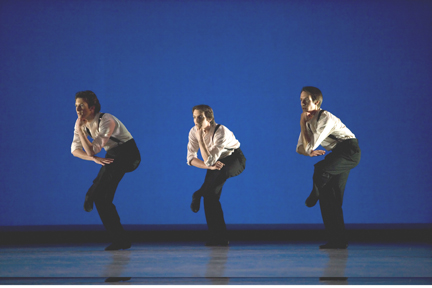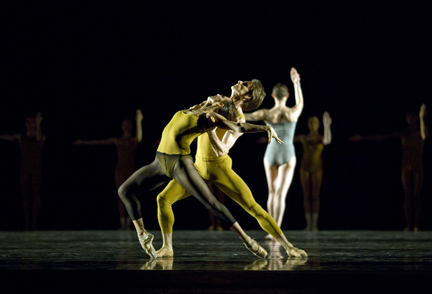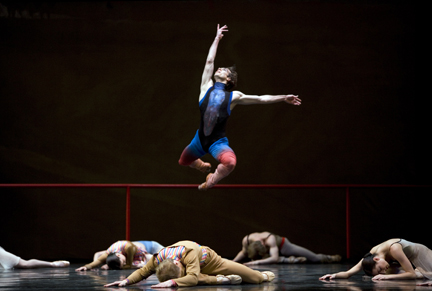San Francisco Letter 21
San Francisco Ballet
Program I
“Divertimento No. 15” “Aunis” “Artifact Suite”
January 30, 2007
Program II
“Blue Rose” “The Dance House” “Firebird”
February 1, 2007
War Memorial Opera House
by Rita Felciano
copyright 2007, Rita Felciano
 San Francisco Ballet’s first program of the 2007 season looked like it had been assembled by a committee charged with making sure that everyone would go home happy. So the lovers of classicism got—albeit in second hand form—Balanchine’s serene “Divertimento No. 15”. Those who like their ballets lite with a dollop of sentiment could relish Jacques Garnier’s “Aunis,” and those who prefer edginess to sentiment could cheer William Forsythe’s “Artifact Suite.” Everyone did go happy—the performances were that fine.
San Francisco Ballet’s first program of the 2007 season looked like it had been assembled by a committee charged with making sure that everyone would go home happy. So the lovers of classicism got—albeit in second hand form—Balanchine’s serene “Divertimento No. 15”. Those who like their ballets lite with a dollop of sentiment could relish Jacques Garnier’s “Aunis,” and those who prefer edginess to sentiment could cheer William Forsythe’s “Artifact Suite.” Everyone did go happy—the performances were that fine.
“Divertimento” has the reputation of being difficult to perform. Maybe. I thought SFB’s performance a gem. What struck me over and over again was its wit, which I think, runs on a parallel track to the music. Mozart’s score starts demurely with just the strings, but almost immediately introduces the horns. It was like somebody opened an elegant salon’s big windows to let in a whiff of the robust outdoor. Maybe a hunting party is riding by. “Divertimento” breathes fresh air and perfume. Throughout these two elements—the contained and the active, the artifice and the “natural”-- co-exist perfectly; separate yet in harmony with each other.
 Balanchine is doing something very similar in the choreography. The architecture of the opening tableau is one of perfect order but splinters quickly to make us see the asymmetry of having three men partner five women. And yet, of course, two uneven numbers end up even, ever so much more interesting than adding even numbers. Thus one aspect of “Divertimento” is an elaborate game of math. On another level this masterpiece, particularly in ‘Theme and Variation’ in which the couples bolt out, and the men return with a different partner, is very funny. It’s an elaborate yet ever so courteous game of hide and seek. And when the women advance with their arms around each other, you almost expect a kick line. And what a delicious use of a coda. The dancers more or less “traipse” around until they find their place in a line-up of the most elegant of bows. “Divertimento” is Balanchine loving twentieth century tribute to the Age of Reason.
Balanchine is doing something very similar in the choreography. The architecture of the opening tableau is one of perfect order but splinters quickly to make us see the asymmetry of having three men partner five women. And yet, of course, two uneven numbers end up even, ever so much more interesting than adding even numbers. Thus one aspect of “Divertimento” is an elaborate game of math. On another level this masterpiece, particularly in ‘Theme and Variation’ in which the couples bolt out, and the men return with a different partner, is very funny. It’s an elaborate yet ever so courteous game of hide and seek. And when the women advance with their arms around each other, you almost expect a kick line. And what a delicious use of a coda. The dancers more or less “traipse” around until they find their place in a line-up of the most elegant of bows. “Divertimento” is Balanchine loving twentieth century tribute to the Age of Reason.
Kristin Long’s as the main ballerina seemed to push some her jumps but delivered her sparkling footwork with a marvel of clarity and speed. Gennadi Nedvigine, surely one of SFB’s most aristocratically refined dancers, timed his crystalline brises ever so musically, and his partnering of a somewhat overly majestic Zahorin’s lush cambres was discrete, yet strong. Rachel Viselli’s floated her liquid lines while Katita Waldo etched hers into our consciousness. Nicolas Blanc phrased the fifth variation splendidly and ever so musically. Frances Chung and Jaime Garcia Castilla completed the cast.
 At the Gala I thought Jacques Garnier’s “Aunis” over-rated; in part, maybe, because the performance seemed so perfunctory. A week later, with a different cast, I remembered why I had loved the piece in the first place. “Aunis” with its folk-inspired accordeon score and a trio of aw-shucks buddies, is an easy charmer. Yet was elevates it above some other folk-inspired work is the intricacy of its design and the richness of its invention. Garnier worked with very simple motives—the circle being the most prominent—and then spun a myriad variations from this very basic folk dance pattern: rotating arms, tight to the body turns, large and small trajectories, overlapping barrel turns, roiling torsoes. Though through-composed, each section has a distinct mood; in one of them the movement seemed to have come from playing ball. This was a fresh, invigorating performance by Rory Hohenstein, promoted to soloist at the end of last season, Garrett Anderson and James Sofranko who managed to introduce an amusing touch of Spanish style bravado into the role.
At the Gala I thought Jacques Garnier’s “Aunis” over-rated; in part, maybe, because the performance seemed so perfunctory. A week later, with a different cast, I remembered why I had loved the piece in the first place. “Aunis” with its folk-inspired accordeon score and a trio of aw-shucks buddies, is an easy charmer. Yet was elevates it above some other folk-inspired work is the intricacy of its design and the richness of its invention. Garnier worked with very simple motives—the circle being the most prominent—and then spun a myriad variations from this very basic folk dance pattern: rotating arms, tight to the body turns, large and small trajectories, overlapping barrel turns, roiling torsoes. Though through-composed, each section has a distinct mood; in one of them the movement seemed to have come from playing ball. This was a fresh, invigorating performance by Rory Hohenstein, promoted to soloist at the end of last season, Garrett Anderson and James Sofranko who managed to introduce an amusing touch of Spanish style bravado into the role.
 Forsythe’s “Artifact Suite” has two primary virtues: you can’t ignore it, and it has guts. It’s also daring, in your face, and skillfully done. Forsythe assembled it in 2004 out of the 1984 “Artifact,” his first piece for Frankfurt Ballet. “Suite” he made immediately after leaving that company. So if there is a rambunctious épater le bourgeois quality to it, it’s probably no mere accident.
Forsythe’s “Artifact Suite” has two primary virtues: you can’t ignore it, and it has guts. It’s also daring, in your face, and skillfully done. Forsythe assembled it in 2004 out of the 1984 “Artifact,” his first piece for Frankfurt Ballet. “Suite” he made immediately after leaving that company. So if there is a rambunctious épater le bourgeois quality to it, it’s probably no mere accident.
But “Suite” is also serious piece about turning ballet conventions inside out. Forsythe gives us blank walls instead of scenery; disruption not continuity; lighting design which does not highlight, but obscures; unisons so regimented they need a drill sergeant; egalitarian pas deux’s which are contentious intead of harmonious; irreverent treatment of great music in the first half, a brutal assaultive score for the second half; primary focus not on soloists, but the group.
Forsythe’s fracturing and pushing almost into the abyss of what Balanchine had started remains an admirable achievement, a kind of act in extremis. The elaborately intersecting patterns of what a friend once called “the magic of unisons”—though she was referring to “Swan Lake”—puts half-time shows to shame. Whether “Suite” will stand up to repeated viewings, especially if less brilliantly performed than it was by SFB, remains to be seen. Muriel Maffre and Vilanoba, as the tall couple, were a miracle of fierce constraint; as the short couple Lorena Feijoo and Pascal Molat just about tore up the stage. The corps performed heroically, drop dead precision propelled by infernal heat.
 The season’s second program proved something of a let down. Helgi Tomasson’s “Blue Rose” is eminently forgettable. The through line of David Bintley’s “The Dance House” is choppy, but the work is musically astute setting of Dmitry Shostakovich’s Concerto for Piano, Trumpet and Strings. SFB Resident Choreographer Yuri Possokhov debut in this new role, “Firebird” is a near miss—with all the contradictions that the term implies.
The season’s second program proved something of a let down. Helgi Tomasson’s “Blue Rose” is eminently forgettable. The through line of David Bintley’s “The Dance House” is choppy, but the work is musically astute setting of Dmitry Shostakovich’s Concerto for Piano, Trumpet and Strings. SFB Resident Choreographer Yuri Possokhov debut in this new role, “Firebird” is a near miss—with all the contradictions that the term implies.
Rather than rely on Fokine, and all the other “Firebirds” that came after, Posskhov tried to start with a clean slate. This “Firebird” is based on the 2004 version for Oregon Ballet Theater — which will be reprised in June — and retains many of its original traces. In both cases Possokhov went back to the fairy tale, the one in which the youngest son, considered the dolt in the family, defeats the villain, solves the riddle and gains the princess. It’s an arch-type that Stravinsky described as “simple, naïve, sometimes even stupid, a good hunter and lover of beautiful women.” The choreographer gives us no sense of a future zsar. Tiit Helimets managed to convey the young hunter’s more doltish and hand-over-fist qualities but he is not enough of an expressive dancer to show us his pure heart. Rachel Viselli, with a toy crown, is the most vivacious and the most daring of a gaggle of young girls, all of whom fall for this matinee idol plopped into their midst. At the climax of the pas de deux — a Mark Morris touch — they all have their hands on their heart. It’s almost ironic that into the playful courting scene, Possokhov introduces traces of the swans protecting their Queen.
 In Oregon, children danced the monsters. SFB’s version looked like mummies, a definite improvement. In the opening image they resemble a rock about to explode. Possokhov’s biggest misstep is the current finale. After the folklorically colored, robust village celebration, everyone steps forward in to a group photo op. In Oregon, the lovers headed for a road winding into open landscape at the end of which you could barely perceived a castle in the distance. It fit the music splendidly. Molat’s Kastei as wildly-leaping villain is somewhat of a caricature; he would but fascinate but not frighten a fairy tale reader.
In Oregon, children danced the monsters. SFB’s version looked like mummies, a definite improvement. In the opening image they resemble a rock about to explode. Possokhov’s biggest misstep is the current finale. After the folklorically colored, robust village celebration, everyone steps forward in to a group photo op. In Oregon, the lovers headed for a road winding into open landscape at the end of which you could barely perceived a castle in the distance. It fit the music splendidly. Molat’s Kastei as wildly-leaping villain is somewhat of a caricature; he would but fascinate but not frighten a fairy tale reader.
Yuan Yuan Tan’s Firebird is the most fully developed character who falls for a prince who loves the chase more than the object. With hips which tremble for being looked at and plies in wide second that open her body, Tan gradually gives in to the hands that break down her resistance and pin down her wings. The evening’s best choreography, full of swooping lifts and dizzing turns, explosive separations and magnetic attractions, the duet’s trajectory soars toward the climactic embrace. Retained from the earlier version is a wonderful chase scene for Kastei’s egg, straight out of a silent movie. Another charmer is the trio in which Helmisett has to choose his bride. Viselli and Tan turn around him in music-box fashion, almost making him dizzy. Tan then fades away, her fingers miming falling tears, her wings broken. She gave her interpretation great pathos.
 Bintley’s “The Dance House”, created for SFB in 1994, was inspired by the loss of friend to AIDS, but in the choreographer’s hand’s the piece became a more generalized Dance of Death. It showcased three very different ballerinas. Set to Dmitry Shostakovich’s somewhat antic Concerto for Piano, Trumpet and Strings, the “Dance” also benefited from painter Robert Heindel’s inspired set and costumes. Behind the red barre, loomed a a greyish, maybe fog-shrouded and barely perceptible backdrop of a house. On the pastel costumes a blood red, later changing to black, a stripe ran from the crotch to the neck. I seem to remember that originally the stripe had continued to right up to under the chin, creating a sense of suffocation.
Bintley’s “The Dance House”, created for SFB in 1994, was inspired by the loss of friend to AIDS, but in the choreographer’s hand’s the piece became a more generalized Dance of Death. It showcased three very different ballerinas. Set to Dmitry Shostakovich’s somewhat antic Concerto for Piano, Trumpet and Strings, the “Dance” also benefited from painter Robert Heindel’s inspired set and costumes. Behind the red barre, loomed a a greyish, maybe fog-shrouded and barely perceptible backdrop of a house. On the pastel costumes a blood red, later changing to black, a stripe ran from the crotch to the neck. I seem to remember that originally the stripe had continued to right up to under the chin, creating a sense of suffocation.
Gonzalo Garcia danced the Death Figure as energetic reflections of the women he was trying to lure into his realm. Solicitous and tender, he almost seduced an innocent Tina Le Blanc, reprising her original role; his passion for Rachel Viselli’s (tenderly partnered by Helimets) languid sensuosity just about brought him to his knees; and with Kristin Long crispness and speed spurred him to a kind of competition. Nedvigine again was splendid in petit allegro, his landing are a marvel to behold. “Dance” ended with the whole ensemble following Garcia Pied Piper-like. What he lacked in his sometimes almost commedia performance was Death’s sense of power and inevitability.
During his twenty-one years at SFB, Tomasson has created some rather deft pieces. “Blue Rose,” set to pop-music inflected miniatures for violin and piano by Uzbekistan-Australian composer Elena Kats-Cherin, is not one of them. The choreography is homespun. Still it was gratifying to see how some of SFB’s finest — Le Blanc, Feijoo, Zahorian, Molat, Vilanoba and Blanc — infused a modicum of spirit into this very modest material.
Photos (all by Erik Tomasson):
Katita Waldo, Nicloas Blanc and Rachel Viselli in Balanchine's "Divertimento No.15."
Kristin Long and Nicolas Blanc in Balanchine's "Divertimento No.15"
Rory Hohenstein, Garrett Anderson and James Sofranko in Garnier's "Aunis."
Lorena Feijoo and Pascal Molat in Forsythe's "Artifact Suite."
Yuan Yuan Tan and Tiit Helimets in Possokhov's "Firebird."
Yuan Yuan Tan in Possokhov's "Firebird."
Gonzalo Garcia in Bintley's "The Dance House."
Volume 5, No. 6
January 29, 2007
copyright ©2007 Rita Felciano
www.danceviewtimes.com